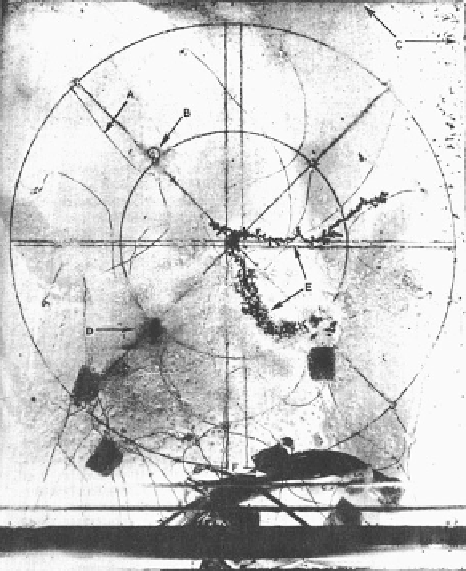Information Technology Reference
In-Depth Information
Fig. 15.4
Gordon Pask's
creative emergent
electrochemical assemblage,
from (Pask
1959
, p. 919). The
photograph looks down on a
glass tank containing an
aqueous solution of ferrous
sulphate and sulphuric acid.
Original caption labels:
A.
Connecting wires for
electrodes.
B.
Platinum pillar
electrodes.
C.
Edges of glass
tank containing ferrous
sulphate.
D.
Chemical
reactioninprogress.
E.
“Tree” threads being
formed.
F.
Connecting cables
medium, such that iron filaments grew outwards to form bridges between the elec-
trodes (Fig.
15.4
). Here the electrodes that extend down into the medium are perpen-
dicular to the plane of the photograph. Iron threads whose conductivity co-varied in
some way with an environmental perturbation were rewarded with electric current
that caused them to grow and persist in the acidic milieu. Through the contingent
allocation of current, the construction of structures could be adaptively steered to
improve their sensitivity. The assemblage acquired the ability to sense the presence
of sound vibrations and then to distinguish between two different frequencies.
We have made an ear and we have made a magnetic receptor. The ear can discriminate
two frequencies, one of the order of fifty cycles per second and the other on the order
of one hundred cycles per second. The “training” procedure takes approximately half a
day and once having got the ability to recognise sound at all, the ability to recognise and
discriminate two sounds comes more rapidly. I can't give anything more detailed than this
qualitative assertion. The ear, incidentally, looks rather like an ear. It is a gap in the thread
structure in which you have fibrils which resonate at the excitation frequency.” (Pask
1960
,
p. 261)
In effect, the device had evolved an ear for itself, creating a set of sensory dis-
tinctions that it did not previously have. Albeit, in a very limited way, the artifi-
cial device automated the creation of new sensory primitives, thereby providing an
existence proof that creative emergence is possible in adaptive devices. As Pask
explicitly pointed out, one could physically implement an analog perceptron with

